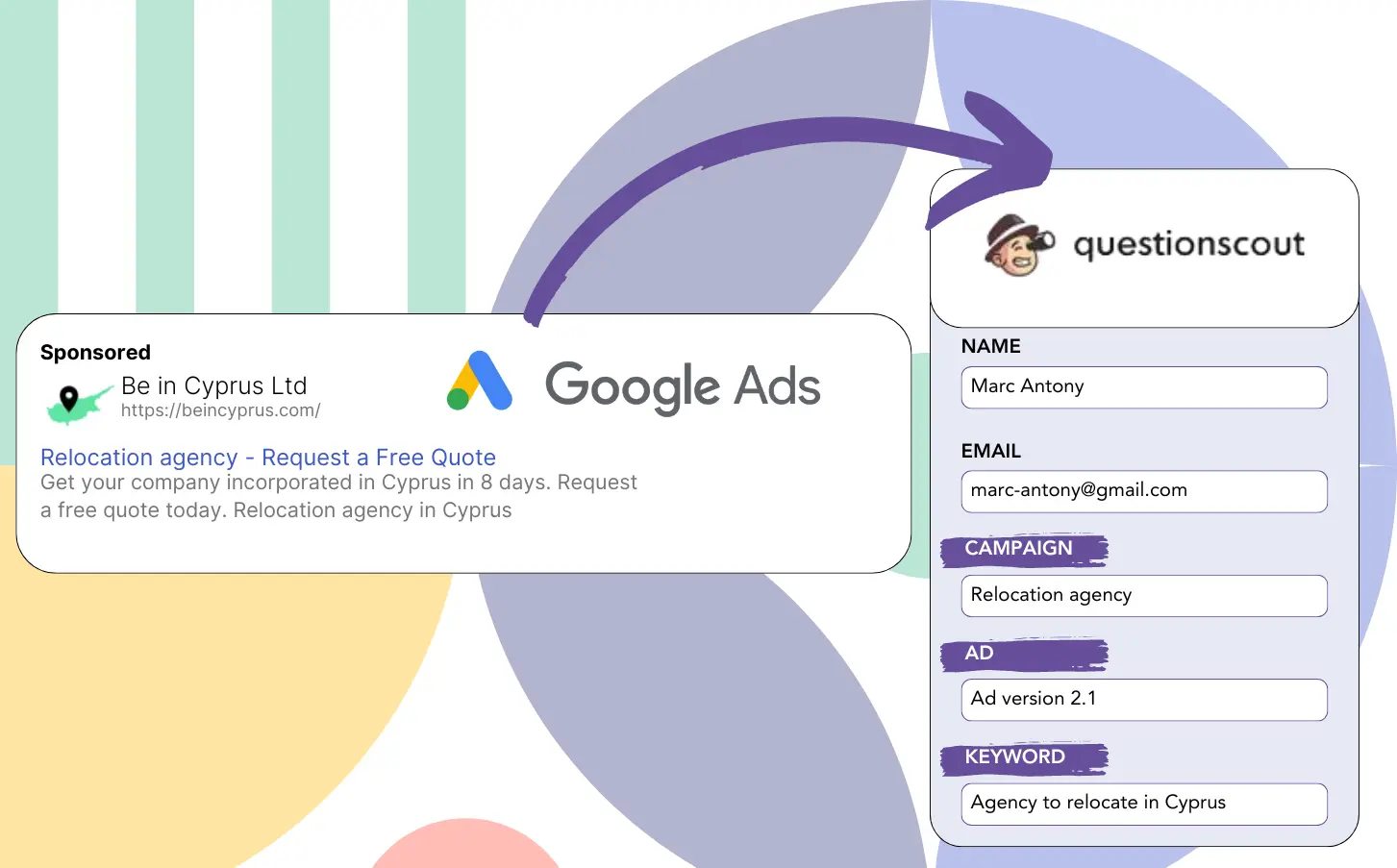Are you uncertain about which Google Ads campaigns are generating your leads?
This is a common issue: Google Ads shows the total number of leads from a campaign, ad, or keyword, but does not provide lead-level data.
Consequently, you cannot determine which campaign, ad, or keyword led to the leads that converted into customers.
Leadsources addresses this issue.
Leadsources enables you to track Google Ads data (campaign, ad, keyword, etc.) at the lead level.
You can store Google Ads data (campaign, ad, keyword, etc.) in QuestionScout for each lead generated.
You can generate reports like “Keywords that produced the most leads” to decide which keywords to promote or cancel.
Let’s get started!
Capture Google Ads lead data in QuestionScout in 4 steps
Step 1: Add Leadsources in the head tag of your website
Sign up to Leadsources.io, and benefit from our 14-day free trial.
Add the Leadsources code to the head tag of your website. No coding skills are needed.
Simply follow this easy step-by-step guide.
Step 2: Add the UTM parameters to your Google Ads campaigns
Add the UTM parameters you wish to track to all your Google Ads campaigns.
Here are examples of UTM parameters you can include in your ad:
- UTM_source
- UTM_campaign
- UTM_term
- UTM_content
Leadsources also gathers data beyond UTM parameters, including the channel, landing page, and landing page subfolder, providing a comprehensive view at the lead level.
Step 3: Add the hidden fields in QuestionScout
When visitors complete your QuestionScout (name, email, etc.), Leadsources automatically fills in the hidden fields with Google Ads data (campaign, ad, keyword, landing page, etc.).
To do this, follow the step-by-step guide to add hidden fields in QuestionScout.
Leadsources will then save the Google Ads data directly in your QuestionScout.
Step 4: Capture the Google Ads data in QuestionScout
When a visitor clicks your Google Ads ad and arrives on your page, Leadsources captures the Google Ads data (campaign, ad, keyword, landing page, etc.).
Leadsources automatically inputs Google Ads data into the hidden fields of your QuestionScout.
After the form is submitted, the Google Ads data (along with the form responses) is sent to the QuestionScout submissions page.
How does Leadsources work?
When you add the Leadsources code to the head tag of your website, it will collect Google Ads data (UTM parameters and referrer) whenever someone visits your site.
It then saves the Google Ads data in the hidden fields of your QuestionScout.
If a visitor arrives on your site without UTM parameters in the URL, Leadsources will still gather data through the referrer:
- Channel
- Source
- Campaign
- Landing page
- Landing page subfolder
This method allows you to track key lead source information even without UTM parameters, including:
- On Google Search
- On your Instagram bio link
- On your social media posts
- Etc.
Most tools only track lead data when UTM parameters are present (typically for paid and referral channels) – this is a limitation!
However, Leadsources collects lead data from all channels, even if UTM parameters are missing:
- Organic Search
- Paid Search
- Organic Social
- Paid Social
- Referral
- Affiliate
- Display Advertising
- Direct Traffic
This enables you to gather and centralize all lead source data in one place.
Pro tip:
Track Google Ads data in all the popular online form builders, including Cognito Forms, Gravity Forms, Jotform, Typeform, WPForms, and more. Learn how to add Google Ads UTM parameters in any form builder.
How to run performance reports
With Google Ads data saved in QuestionScout, you can now generate performance reports like:
- Leads per campaign
- Leads per ad
- Leads per keyword
- Etc.
This helps you make informed decisions about your Google Ads spending.
Let’s examine the different reports you can generate.
Lead performance reports
You can generate reports that display the number of leads produced by:
- Channel
- Campaign
- Ad
- Keyword
- Landing page
- Landing page subfolder
Example #1
For campaigns across various channels (SEO, PPC, email, etc.), you can export the data and create a report titled “Leads by Channel.”
Example #2
After identifying which channel generates the most leads (e.g., Google Ads), you can refine your view by selecting that channel to see the lead count for each specific ad campaign.
Example #3
After identifying the campaign with the most leads, you can investigate further by analyzing which specific keywords are driving these leads.
Sales performance report
Identifying which ads and keywords generate the most leads is helpful, but does this also mean they boost your revenue?
By transferring your QuestionScout submissions to a CRM, you can create detailed sales reports.
Example:
| Channels | Search Paid | Social Paid |
| Leads | 50 | 75 |
| Sales | 5 | 6 |
| Average order value | $150 | $100 |
| Revenue | $750 | $600 |
After advertising on Google and Facebook, you discovered that Social Paid ads produced more leads than Search Paid ads.
After a few weeks of analysis, you found that the Search Paid channel generated more revenue with fewer leads compared to the Social Paid channel. This suggests increasing the budget for Search Paid campaigns.
LeadSources tracks the source of each lead in QuestionScout, whether they come from ads, organic search, social, email, etc. and syncs that data with each submission. See the full breakdown on the lead source in QuestionScout page.
